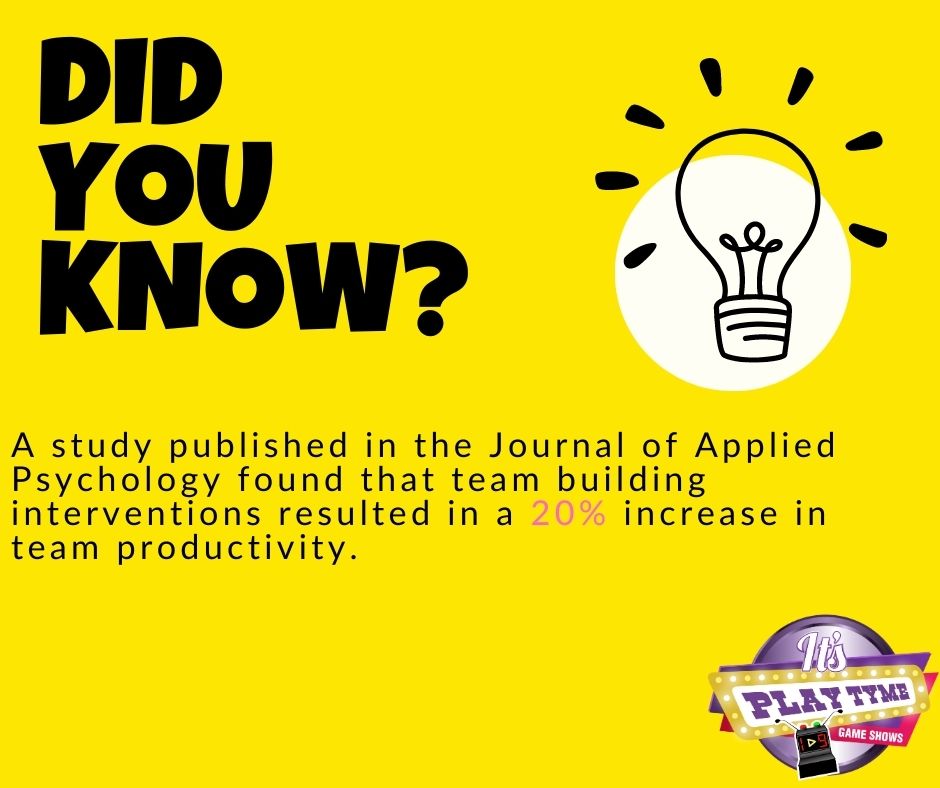Welcome to this article exploring employee motivation techniques that can significantly enhance productivity in the workplace.
As a professional Team Building Facilitator, I have researched and compiled proven strategies to motivate and engage your employees, resulting in improved performance and success for your team.
Employee motivation is critical to the success of any organization.
Here, we will dive into the concept of employee motivation.
Let’s explore ways to improve motivation in the workplace, including setting clear goals and expectations, providing recognition and rewards, cultivating a positive work culture, offering development opportunities, and enhancing communication and feedback.

Key Takeaways:
- Employee motivation is crucial to the success of any organization
- Effective employee motivation techniques can significantly enhance productivity in the workplace
- Setting clear goals and expectations is crucial for motivating employees
- Recognizing and rewarding employees for their efforts can significantly impact motivation levels
- A positive work culture plays a fundamental role in employee motivation
Understanding Employee Motivation
As a copywriting journalist, I understand the significance of employee motivation techniques for enhancing productivity in the workplace.
To improve employee motivation, it is imperative to understand what drives employees to perform better.
There are several ways to improve employee motivation, and it all starts with creating a work environment that fosters motivation and engagement.
Effective employee motivation techniques encompass a range of motivational methods for employees that can make a significant difference in productivity.
Importance of Effective Employee Motivation Techniques
The primary importance of effective employee motivation techniques is to drive employees to perform at their best consistently.
Strong motivation can lead to increased productivity, better job satisfaction and morale, and a sense of belongingness to the organization.
Effective employee motivation techniques are vital to retaining top talent, enhancing employee engagement, and creating a positive work culture.
A motivated workforce can lead to better outcomes and ultimately increase an organization’s ROI.
5 Motivation Methods for Employees
There are several motivation methods for employees that organizations can implement to create a motivating work environment. Here are a few effective employee motivation techniques:
- Setting clear and achievable goals
- Providing regular feedback and recognition
- Investing in employee development opportunities
- Fostering open communication channels within the team
- Creating a positive work culture
Implementing these employee motivation techniques can lead to higher productivity, engagement, and job satisfaction.
Ways to improve employee motivation are numerous, and it’s necessary to identify the right approach for each employee.
What motivates one employee may not work for another, so it’s essential to understand each team member’s drivers and preferences.
Stay tuned for the next section, where we will explore the importance of setting clear goals and expectations and how it can enhance employee motivation.
1 – Set Clear Goals and Expectations
One of the most effective employee motivation tips is setting clear goals and expectations.
When employees have a clear understanding of what they need to achieve, they are more motivated to work towards those goals.
The key is to set SMART goals, which are Specific, Measurable, Achievable, Relevant, and Time-bound.
Here’s an example of a SMART goal:
| Specific | Measurable | Achievable | Relevant | Time-bound |
|---|---|---|---|---|
| Develop a new marketing campaign for our latest product | Generate 100 new leads within the next 3 months | Allocate a budget of $10,000 for the campaign | Align with the company’s overall marketing strategy | Complete the campaign by the end of the quarter |
Once you have set clear goals, it’s essential to communicate them effectively to your team. Make sure everyone understands what they’re working towards and how their efforts contribute to the organization’s overall success.
This will help employees stay motivated and focused on achieving their goals.
Another way to motivate employees is to align their individual goals with the organization’s objectives.
When employees can see how their work impacts the company’s success, they are more invested in achieving their goals.
This helps create a sense of purpose and belonging, which can boost motivation and drive productivity.
Techniques to Motivate Employees
Once you have set clear goals and expectations, there are several motivational techniques for the workplace that you can use to help employees stay motivated:
- Provide regular feedback: Employees need feedback to know if they’re on track to achieving their goals.
Regular feedback helps them stay focused and motivated. It’s essential to provide constructive feedback that helps employees improve their performance. - Recognize and reward: Recognizing and rewarding employees for their efforts is an effective way to motivate them.
It can be as simple as acknowledging a job well done or offering incentives for achieving specific goals.
Rewards can be financial or non-financial, such as extra time off or a company-wide announcement of their success. - Encourage collaboration: Encouraging collaboration and teamwork can help employees feel more connected to their colleagues and the organization.
This sense of belonging can boost motivation and drive productivity. It’s essential to create a positive work culture that encourages open communication and collaboration.

2 – Providing Recognition and Rewards

Employee motivation techniques are often centered around recognition and rewards.
When employees feel appreciated and valued, they are more likely to be motivated and engaged.
To implement effective recognition and reward strategies, it’s essential to understand what employees want and need.
One technique to motivate employees is to provide verbal recognition for a job well done.
This can be as simple as thanking an employee for their hard work or acknowledging their contributions during a team meeting.
Another technique is to offer tangible rewards such as gift cards, bonuses, or time off.
It’s important to tailor rewards to individual employees’ preferences and motivations. For example, some employees may be motivated by financial incentives, while others may prefer non-financial rewards such as extra time off or access to training programs.
| Types of Rewards to Consider: | Examples: |
|---|---|
| Financial | Gift cards, bonuses, raises, profit sharing |
| Non-Financial | Extra time off, flexible schedules, recognition programs, work from home options |
Implementing recognition and reward programs can be a powerful motivator for employees. When done right, these programs can improve employee morale, engagement, and overall performance.

3 – Cultivating a Positive Work Culture
A positive work culture is essential for employee engagement and motivation.
By fostering a supportive environment that encourages collaboration and growth, you can boost employee morale and elevate productivity.
Here are some effective employee engagement strategies to cultivate a positive work culture:
- Encourage communication: Open and transparent communication channels are crucial for a positive work culture.
Encourage employees to share their thoughts and ideas, and create an environment where feedback is welcomed and appreciated. - Lead by example: Leading by example is an excellent way to create a positive work culture.
When employees see their leaders practicing what they preach, they are more likely to follow suit. - Promote work-life balance: Encourage employees to maintain a healthy work-life balance by offering flexible schedules and remote work options, if possible.
This shows that you value their well-being and can increase their motivation to work efficiently. - Provide opportunities for growth: Offering employee development opportunities, such as training programs or mentorship, can show employees that you are invested in their growth and success.
This can increase their motivation to perform well and contribute to the team’s success. - Celebrate successes: Recognize employees’ achievements and successes, no matter how small. This will help create a culture of excellence and can motivate employees to work harder and achieve more.
By implementing these techniques, you can create a positive work culture that fosters employee engagement and motivation.
Remember, a positive work culture is an investment that pays dividends in terms of employee satisfaction, productivity, and overall success.
4 – Provide Development Opportunities

Providing Development Opportunities – Mentorship
Employees are motivated when they have opportunities for growth and development.
As a manager, it is essential to identify and provide development opportunities to reinforce their motivation, knowledge, and skills.
Employees who feel valued and recognized will respond positively to these opportunities, and their motivation levels will increase.
To achieve this, create a roadmap for each employee, outlining achievable goals and objectives that align with their career aspirations.
This plan should include stretching assignments, learning and development programs, and mentorship opportunities.
A development plan that focuses on employees’ professional goals will help them feel valued, invested in, and motivated to achieve their full potential.
Training programs
Training programs are a powerful motivation tool that can provide employees with the necessary skills to do their jobs effectively.
These programs can include workshops, seminars, eLearning modules, or external courses.
Offering training opportunities will help to build a more competent and productive workforce, which, in turn, will enhance employee satisfaction and motivation.
A study shows that participants in employee training programs experience higher job satisfaction and motivation levels than those who did not participate in any programs.
Investing in the professional development of your team members can boost their self-confidence, skillset, and drive, leading to increased productivity and a higher quality of work.
Mentorship opportunities
Mentorship opportunities are also effective in boosting employee motivation and engagement.
By pairing experienced employees with those who are less experienced, knowledge-sharing and skill-building can take place.
This type of development opportunity can help employees to gain a better understanding of their role, learn new skills, and develop professionally.
Furthermore, mentorship can also help to build strong working relationships and increase employee engagement.
Career Advancement Paths
Employees need to know that their professional growth is supported and encouraged, and career advancement paths provide a clear route for them to achieve their career goals.
A career path allows employees to see how they can develop their skills and advance within the organization.
By providing a clear progression plan, you can instill a sense of direction and purpose in your employees, which can lead to increased motivation and higher levels of job satisfaction.
Providing development opportunities is essential for keeping employees motivated and engaged.
By identifying areas for growth and providing the support they need to achieve their career aspirations, you will create a workforce that is committed, invested, and driven to succeed.
5 – Enhancing Communication and Feedback
Effective communication and feedback are essential for promoting employee engagement and motivation in the workplace.
As a manager, it’s crucial to foster open and transparent communication channels within your team, ensuring that employees feel heard, empowered, and valued.
One effective way to prioritize communication is by scheduling regular check-ins with individual team members or holding team-wide meetings to discuss progress, concerns, and ideas for improvement.
By demonstrating a willingness to listen and respond to feedback, you can create an environment of trust and collaboration, allowing employees to feel more invested in their work.
“Communication is the real work of leadership.” – Nitin Nohria, Dean of Harvard Business School
When providing feedback, it’s essential to offer constructive criticism that highlights specific areas for improvement while also recognizing and celebrating accomplishments.
By striking this balance, you can motivate employees to continue working hard while also providing clear guidance for growth and development.
Another way to enhance communication and feedback is by utilizing technology.
Tools such as instant messaging platforms, project management software, and online suggestion boxes can help facilitate communication within and between teams, making it easier to coordinate efforts and stay on top of tasks.
Ultimately, effective communication and feedback form the foundation of any successful team, enabling employees to feel connected, supported, and engaged in their work.
By prioritizing these elements in your management style, you can boost employee motivation and inspire your team to achieve their best.
FAQ – Top Employee Motivation Techniques

frequently asked questions
What are employee motivation techniques?
Employee motivation techniques are strategies and methods used to inspire and encourage employees to perform at their best and achieve their goals.
These techniques aim to increase motivation, engagement, and productivity in the workplace.
Why is employee motivation important?
Employee motivation is important because motivated employees are more likely to be productive, engaged, and committed to their work.
Motivation boosts job satisfaction, encourages creativity, and improves overall performance, leading to better organizational success.
How can I improve employee motivation in the workplace?
There are several ways to improve employee motivation.
Some effective techniques include setting clear goals and expectations, providing recognition and rewards, cultivating a positive work culture, offering development opportunities, and enhancing communication and feedback.
What are the benefits of recognizing and rewarding employees?
Recognizing and rewarding employees can have numerous benefits.
It boosts morale, increases job satisfaction, and enhances employee engagement. It also encourages a sense of accomplishment, motivates employees to perform better, and fosters loyalty and retention within the organization.
How can I cultivate a positive work culture?
Cultivating a positive work culture involves creating an environment that embraces collaboration, respect, and support.
This can be achieved by promoting open communication, fostering teamwork, providing opportunities for growth, and encouraging work-life balance.
A positive work culture enhances motivation, productivity, and overall job satisfaction.
How do development opportunities impact employee motivation?
Development opportunities such as training programs, mentorship, and career advancement paths can significantly impact employee motivation.
These opportunities provide employees with a sense of progress, personal growth, and the chance to enhance their skills and knowledge.
They help employees feel valued and invested in, leading to increased motivation and engagement.
What role does effective communication play in employee motivation?
Effective communication is crucial for employee motivation. It ensures that expectations, goals, and feedback are clearly conveyed, reducing confusion and misunderstandings.
Open and transparent communication channels foster trust, engagement, and collaboration, ultimately increasing motivation and overall team effectiveness.

team productivity
Conclusion
Boosting employee motivation is essential for creating a high-performing team and achieving success in the workplace.
By implementing effective employee motivation techniques, you can inspire and empower your team to reach their full potential.
Understanding what motivates your employees is the first step towards creating a motivational work environment.
From setting clear goals and expectations to providing recognition and rewards, there are a variety of techniques you can use to enhance employee motivation.
Cultivating a positive work culture and providing development opportunities are also crucial for boosting employee motivation.
By investing in your employees’ growth and creating a supportive work environment, you can create a culture of excellence within your organization.
Enhancing communication and feedback is yet another important way to increase employee motivation.
By fostering open and transparent channels of communication, you can provide constructive feedback that motivates employees to improve their performance.
Overall, by using a combination of these employee motivation techniques, you can create a work environment that inspires and empowers your team to achieve outstanding results.
So, start implementing these techniques today and see the positive impact it has on your team’s motivation and productivity!
Got Team Builder Games?
![]()
Book a live game show experience today!
Contact us for further details.
For Immediate assistance by text – 917-670-4689
No deposit required.
We plan and facilitate all activities.





